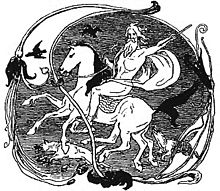Sleipnir
In Scandinavian mythology, Sleipnir or Sleipner (Old Norse: "the slippery one") is an eight-legged gray horse. Sleipnir is mentioned in the Poetic Edda, compiled in the 13th century from ancient sources, and in the Prose Edda, written by Snorri Sturluson in the 13th century. In both sources it is indicated that Sleipnir belonged to Odin, and was the son of Loki and Svaðilfari, he is described as the best of horses, and is sometimes ridden to reach Hel itself (Kingdom of death). The Prose Edda contains a great deal of information about the circumstances of Sleipnir's birth, also indicating that he was gray in color. He was able to go quickly from one end of the horizon to the other. Sleipnir symbolized the eight winds that blow from their respective cardinal points, he had runes engraved on his teeth.
Sleipnir is referred to in some sources as a six-legged horse.
Hervarar saga ok Heiðreks
In the Hervarar saga ok Heiðreks, the poem Heiðreks gátur contains a riddle that mentions Sleipnir and Odin:
- 36. Gestumblindi said:
- «Who is the couple
- What's with ten legs?
- He's got three eyes,
- But just a tail?
- Now try to solve
- this riddle, Heithrek!"
- Heithrek replied:
- “The divination is ingenious, Gestumblindi,
- and I think he added his solution:
- It's Odin riding Sleipnir. »
Mythology
The Birth of Sleipnir
In the upper realm of Asgard, the Gods were restless. Their home had no walls to protect them from enemies, so when a horseman appeared and offered to build a wall, they listened without hesitation.
- - It will be a great wall — he told them, — a barrier against enemies. Within sixteen months, your concerns will be over.
- - And what is your price?" asked Odin the wise.
- - Only the goddess Freya—contested the unknown. And also the Sun and Moon.
The gods were enraged, and would have cast the man out of Asgard for daring to think that the beautiful Freya could be traded for a masonry job. But Loki (one of the gods) replied:
- - If you can build the wall in six months, deal done. And the other gods whispered to them. In six months you can only build half, but at least this one will go free.
The builder looked at Freya, who was bathing in golden tears, and agreed, as long as he was allowed to use his horse. During the winter, the foreigner worked, and with his horse he carried enough stones to build a great wall around Asgard. As summer approached, disaster was imminent for the gods, as the construction was about to be completed.
- - You thought you were smart, Loki — Odin said. You got us into this and you got to get us out. We can't allow Freya to marry that mason, which must be a disguised giant. And without the Sun and Moon, it's not worth living. So do something!
Loki reflected and said:
- - Without the horse, you will not be able to transport the stones to finish your work.
Loki had the ability to change shape, and that night, disguised as a beautiful mare, he tricked Svadilfari, the builder's horse. Realizing that he could not finish his work on time, the builder flew into a rage, falling off his disguise and revealing himself as a giant, enemy of the gods. Thor, son of Odin, went to meet the giant and hit the builder with a hammer blow from Mjolnir to the head. As for Loki, when he thought that appearing in Asgard did not imply any danger, he returned pregnant as a mare and gave birth to Sleipnir, a strange eight-legged horse. Loki gave that horse to Odin, saying:
- - No horse will match this speed. He will take you by sea, land and air, also to the Land of the Dead and back here.
Just as Loki promised, Sleipnir never failed his new master, Odin.
Contenido relacionado
Morpheus
Hermione (mythology)
Tecciztecatl

